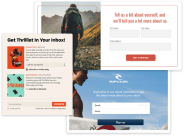Introduction
As a marketer, you probably know that email is one of the most effective communication channels available to you today. However, the success of your email marketing efforts largely depends on the size and quality of your email list.
So how do you build a great list that gets results for your business?
This guide will make it easy for you. By reading it, you’ll learn the two-step process for capturing email addresses and get a number of tools you can use to build a massive email list that grows your business.
Chapter 1
Introduction to email lists
Simply put, an email list is a list of individual email addresses that you have permission to send email campaigns to.
Email lists can be built in a number of ways, and could include people who have:
- Purchased something from you
- Subscribed via your website
- Signed up for your product
- Given you their business card at an event
Building your email list is one of the most important activities marketers like you can focus on, and here’s why:
- Get your products and services seen by more people. Whether your emails contain updates on your latest products, discounts to drive sales, or an invitation to your next event, focusing on building your email list will ultimately result in more people seeing your products and services and clicking through to purchase.
- Keep your list fresh and up to date. It’s an unfortunate fact of life that occasionally email addresses become invalid. People’s work email addresses change as they move between companies and others abandon old AOL email addresses in favor of modern platforms like Gmail. However, by focusing some of your time and energy on building your email list, you can fight list decay and ensure you have a growing list of people to receive and click-through on your email campaigns.
Chapter 2
A 2-step process for building your email list
Building a high-quality list doesn’t take a ton of learning or skills—but it does require patience and perseverance.
Fortunately for you, there is a two-step process for building your email list , and it’s followed by many of the most successful marketers around.
Step 1: Create simple subscribe opportunities
The first step in building a massive email list is making it incredibly simple for people to subscribe.
To help you with this, we’ve outlined some of best ways we’ve seen businesses create simple subscribe opportunities across their website, social channels, etc.
Here are a few ideas.
Your website
If a lot of your customer interactions happen via your website, then including a subscribe form there is a great way to build your email list.
But where exactly should you include it? There are an almost infinite number of options, but here are some of the most effective we’ve seen:
Checkout or signup process
If your business sells something online, then you can use your email signup and/or checkout forms to capture email subscribers.
Clothing brand Nau does a good job of this during their checkout process.
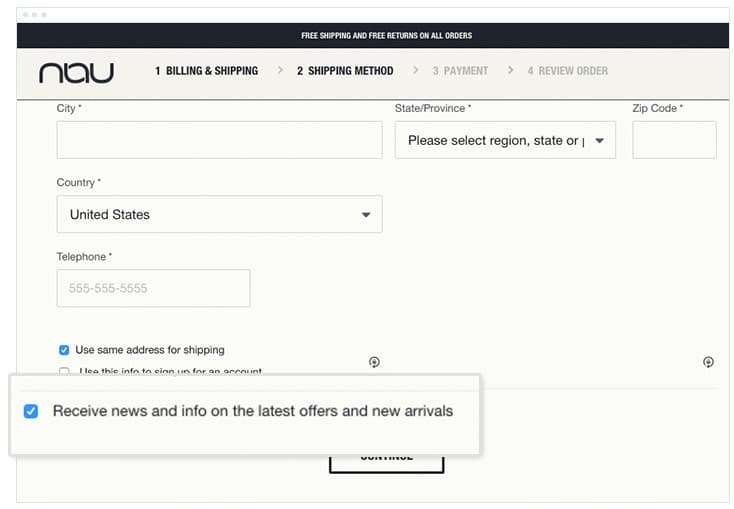
Given that people are already entering their name and email address as part of the checkout process, including a small tick box to join their email list makes it super simple for people to subscribe.
Contact form
If your website has a form where people can contact you, request a quote, etc. then adding a subscribe tick box is a great way to capture new email subscribers. These people are entering their details into the form already, and clearly, have a strong interest in what you offer.
ConversionLab does a great job of this on their website, including a simple opportunity to subscribe to their newsletter at the bottom of their website’s contact form.
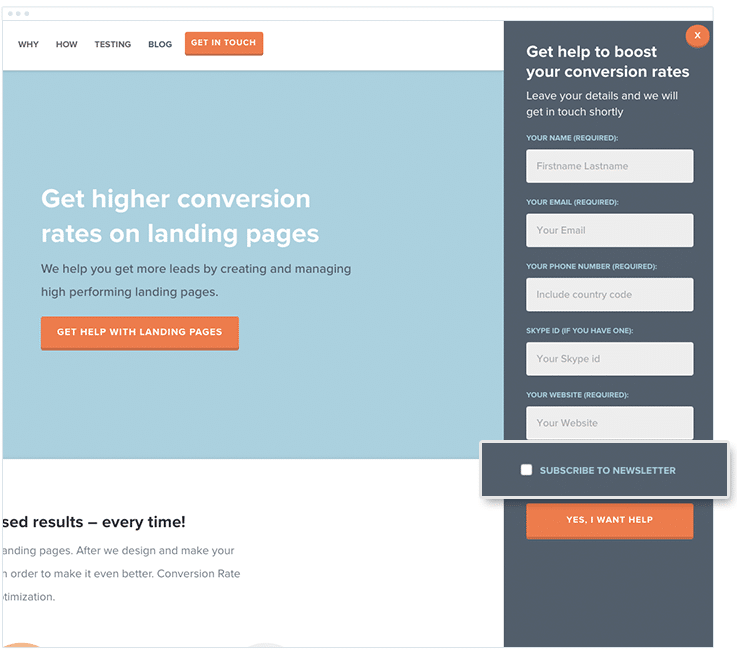
Blog
If you run a blog to help build your business, then this is a great place to be adding a subscribe form. In fact, people who subscribe to your blog will likely be some of most valuable readers, accounting for majority of your comments and sharing your content 3x more than other visitors.
Campaign Monitor customer Freshbooks do a good job of this. They offer a simple subscribe opportunity in a prominent popup that appears once you’ve been on their blog for a certain amount of time.
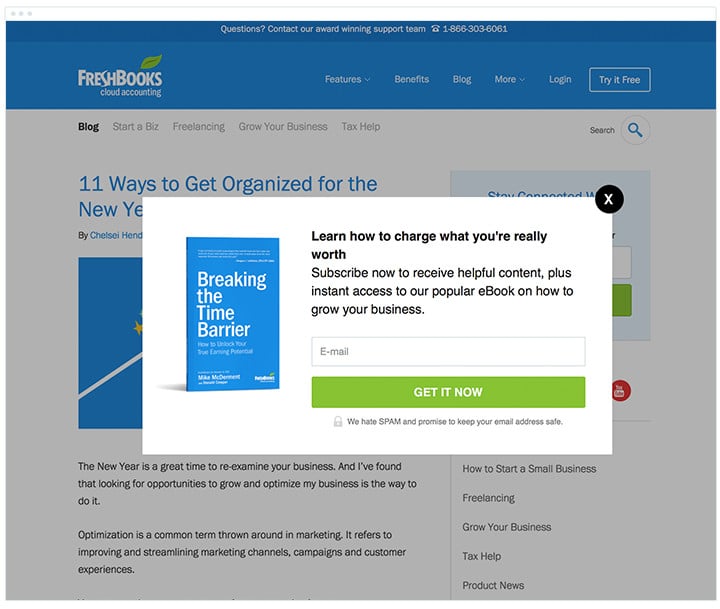
Your social channels
If you have built a following on social media channels like Facebook, then it’s a good idea to try and convert them into email subscribers as well.
With Facebook intentionally limiting the number of times your posts appear in your followers newsfeed, it’s becoming increasingly important to try to engage those people on more reliable channels, like email.
But how do you do it? There are a number of different methods for allowing people to subscribe to your email list from your social channel, but here are two of our favorite:
Consistently giving opportunity
Social media is a constantly-changing and evolving platform—not only in its tech, but in its viewership. The very nature of social media is seeing the most up-to-date info from the people you follow.
So link out to your subscribe form often. People probably won’t be bothered by it, but those that find interest and value in your content may need nudges from time to time to sign up, simply because they may not log on from one day to the next.
Twitter Lead Generation Cards
If your business is active on Twitter, then a great way to convert your followers into email subscribers is using Twitter’s Lead Generation Cards.
A Lead Generation Card is simply a link you include in your tweet that expands it out to allow people to subscribe to your list directly from the Twitter interface.
It pre-populates a user’s full name, @username and email address (as entered in their Twitter account settings) into the expanded area of your Tweet, meaning they can subscribe without having to manually enter their details.
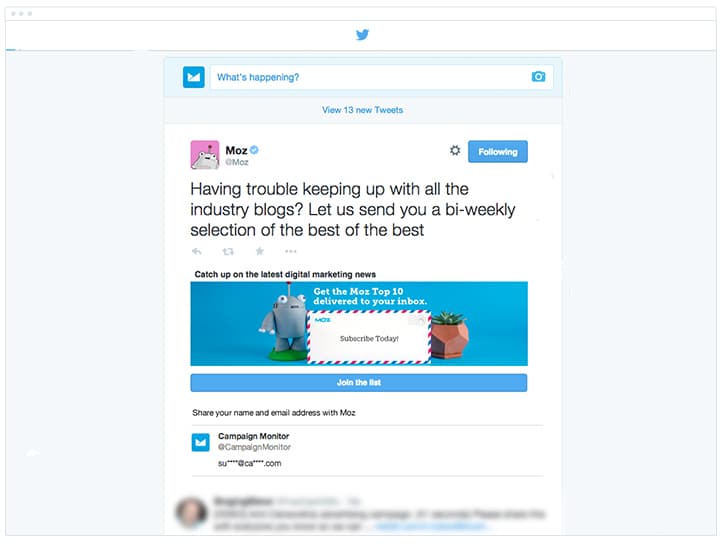 Some of the best ways we’ve seen this done are:
Some of the best ways we’ve seen this done are:
- Tweeting about your list – Send out a tweet promoting your email list to your followers and ask them to subscribe for great new content. Include the link to the lead generation card in the tweet so that they can subscribe with one click.
- Replying to people who tweet about your business – If people are tweeting about your business or your content online, then you can reply to them asking them to subscribe to your email list and include the link to the lead generation card so they can join with just one click.
Your email signature
Depending on the size of your organization, you are probably sending hundreds or even thousands of emails to customers and prospects each month.
These personal emails from you and your team are often highly engaged with, and therefore the perfect place to promote your newsletter and get people to subscribe.
Heartbeat does a great job of this in their employee’s email signatures, including a link to a landing page that makes it simple for people they do business with to subscribe to their email list.
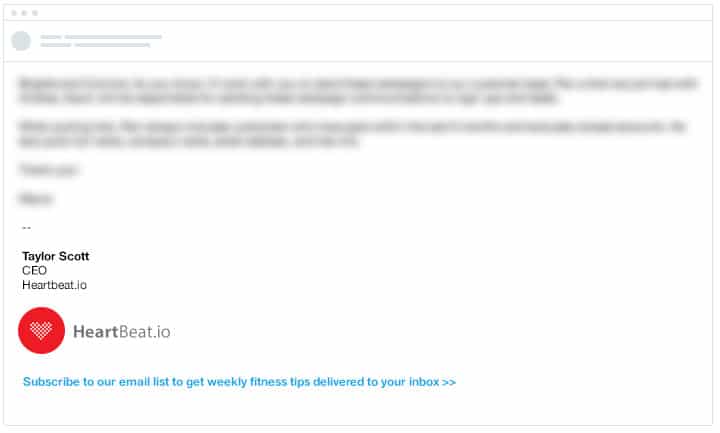
In-person
For some businesses, online channels like social media and the website simply aren’t the most common customer touchpoints.
Retail stores, for instance, interact with their customers face to face much more frequently than they do online. So how can these businesses provide simple subscribe opportunities to people to encourage them to join their email list?
Ask at point of sale.
By getting your employees to ask every customer at the point of sale if they’d like to join your email list (in return for a small discount on their purchase for instance), you’re hitting every possible customer with a very compelling and simple offer.
Stationery company Paradise Pen Co. has seen considerable success with this strategy, collecting 80% of their customer emails in-store.
Paradise uses gift cards of small monetary amounts to incentivize people to subscribe to their list. They initially tried paper gift certificates, but when they switched to using plastic gift cards that could be redeemed online, gift card redemption rates jumped from 9.5% to 20%.
Not only did doing this build their email list but with such high redemption rates and most users spending more than the gift card amount, they were able to drive sales & revenue as well.
Place a subscribe form in-store.
One of the easiest ways to get started capturing email addresses in person is to set up a basic signup form in-store.
You can do this the old-fashioned way by simply placing a pen and paper on the counter and presenting your chosen incentive.
If you want to get more advanced and save yourself some of the hassle of manually adding your customer’s email address to your email marketing software, you could use an app to turn your iPad into a beautiful email subscribe form.
Collect business cards.
Manually writing down an email address is a pain, and can be a barrier to entry that prevents your customers from subscribing to your list.
Fortunately for you, many people have their email address on their business card and providing a method (such as a glass bowl) to drop their business card into is a great way to collect emails.
Step 2: Offer a valuable incentive
Now that you’ve made it simple for people to subscribe to your email list, then next step is to give them some incentive to do so.
There are an infinite number of ways in which you can provide an incentive for people to join your email list, and the right one depends on the type of organization you are marketing.
For instance, online fashion stores are likely going to have different incentives they can offer than a financial services firm, so the key is to pick out what makes sense for your business to offer based on what would resonate with your audience.
Great content
If you have a blog or are using other content marketing techniques to attract visitors, then relevant, high-quality content is a great incentive to offer people to get them to join your email list.
This can take many forms, and we’ve seen many companies excel using a variety of methods.
For instance, the folks over at Buffer write some amazing content on social media marketing and productivity on their blog. The quality of the content they offer is a valuable enough incentive to entice 1000+ people each week to subscribe to their email list just to receive updates when new blog posts are published.
However, the team at ConversionLab take a slightly different approach. They offer an exclusive incentive (in this case, 7 conversion rate optimization tips delivered via email) that isn’t available anywhere else on the web, encouraging people to hand over their email address to get the incentive and ultimately join their list.
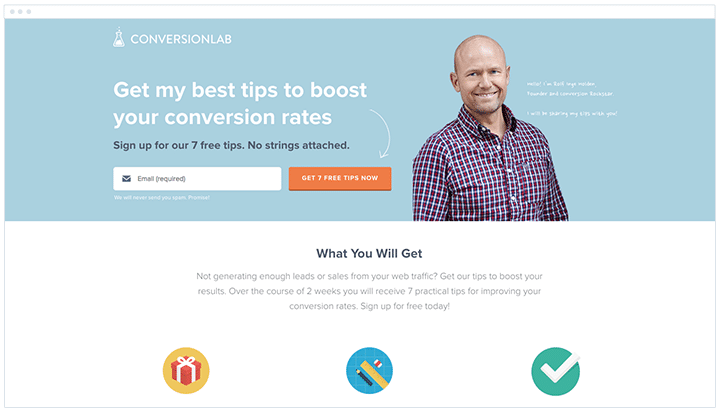
Regardless of what approach you take, the key thing is to ensure your content is high quality and relevant to your audience, otherwise, it isn’t enough of an incentive for visitors to give over their email address.
Discounts and offers
If you sell something online, then offering discounts or presenting various other value-added offers can be a great incentive for people to join your email list.
For instance, online cosmetic store La Mer offer a fantastic first-order discount to new visitors to incentivize them to join their email list.
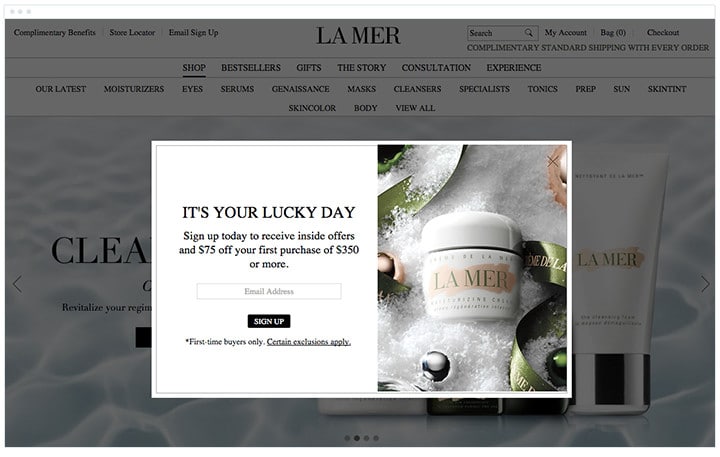
This is a particularly effective technique as not only is the potential to save money a great incentive to subscribe to their email list, but the actual discount itself is also a great motivator to make a purchase. So by offering first-order discounts to potential customers, La Mer is both building their email list and increasing sales at the same time.
Early access and exclusive promotions
If you have built up a reasonable level of brand love over the years, then offering early access and exclusives as an incentive to subscribe to your email list can be extremely cost-effective.
For instance, hair care company Oribe has thousands of loyal followers around the world and offers exclusive, early access to new products and promotions as an incentive to subscribe to their email list.
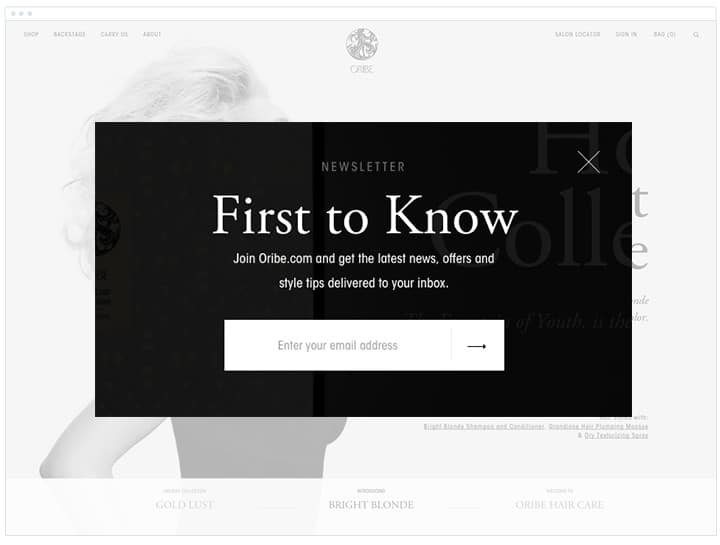
Chapter 5
Tools to help you build your email list
Now that you know the two-part formula for building your email list, have thought about the kind of amazing incentives you could offer, and devised where to place your simple subscribe opportunities, it’s time to put it all into action.
To help you out, we’ve pulled together a list of tools that you can use to help you build a massive email list that grows your business.
Campaign Monitor Tools
If you’re a Campaign Monitor customer, there are a number of free tools available to you (accessible within the app) to help you build your email list. These include:
Subscribe button
The Subscribe Button is a small and elegant button you can add to your website to allow people to subscribe to your email list. When clicked, a small popup appears where people can enter their email address.
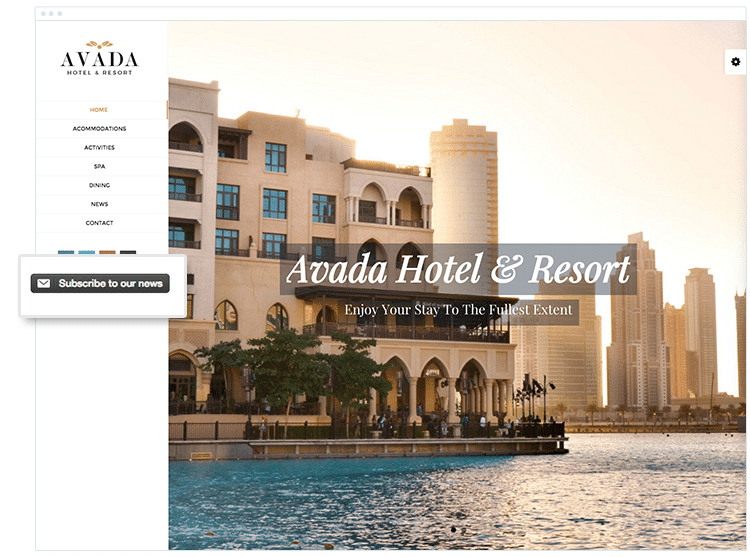 These email addresses are then automatically added to your chosen email list in Campaign Monitor. To get started using the subscribe button, follow the instructions in this help article.
These email addresses are then automatically added to your chosen email list in Campaign Monitor. To get started using the subscribe button, follow the instructions in this help article.
Subscribe form
The Subscribe Form is a simple HTML form you can add anywhere on your website. You can set exactly what fields you want to capture (i.e., Name, Email, Location, Gender, etc) and it seamlessly integrates into the style of your website.
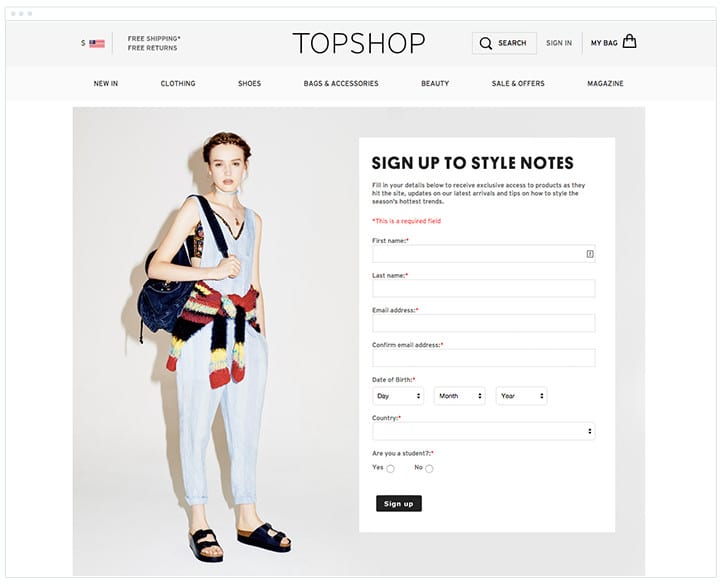 Any email address entered into the Subscribe Form are automatically added to your chosen email list in Campaign Monitor. To get started using the subscribe form, follow the instructions in this help article.
Any email address entered into the Subscribe Form are automatically added to your chosen email list in Campaign Monitor. To get started using the subscribe form, follow the instructions in this help article.
Subscribe page
The Subscribe Page is a landing page dedicated solely to capturing subscribers. It’s customizable to suit your brand and you can set exactly what fields you want to capture (i.e., Name, Email, Location, Gender, etc.).
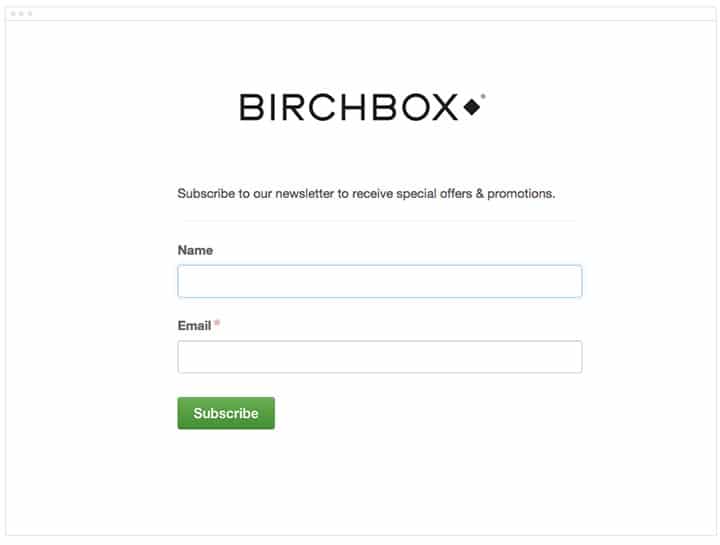 All email addresses entered into the Subscribe Page are automatically added to your chosen email list in Campaign Monitor. To get started using the subscribe form, follow the instructions in this help article.
All email addresses entered into the Subscribe Page are automatically added to your chosen email list in Campaign Monitor. To get started using the subscribe form, follow the instructions in this help article.
Third-party tools
For those looking to get a bit more advanced with their email subscribe forms, there are a number of third party tools available that integrate directly with Campaign Monitor to pass any email addresses captured into your chosen email lists.
These third party tools offer more advanced functionality than the default Campaign Monitor tools mentioned above, but can also cost an additional fee.
SumoMe
SumoMe is a suite of tools that help you offer simple subscribe opportunities. Using SumoMe, you can add more advanced types of subscribe opportunities like popups, slide-ins, and header bars.
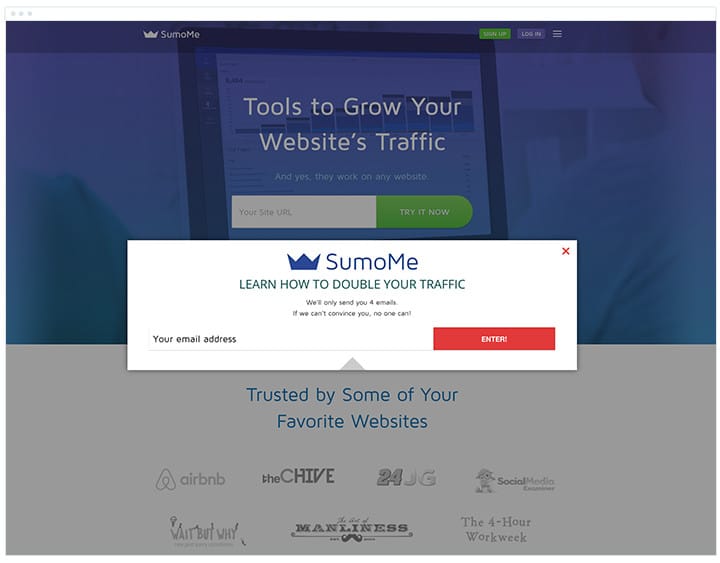
Best of all, SumoMe’s suite of tools integrate directly with Campaign Monitor, so you can automatically send any emails you capture through the tool straight to your chosen list.
Optin Monster
Optin Monster is an advanced tool that allows you to add various types of subscribe opportunities to your website, including popups, slide-ins, header bars and more.
It features advanced customization and targeting options that allow you to show the subscribe opportunity on specific pages of your website or to specific visitors (like people coming from Facebook, or people who have never visited your site before).
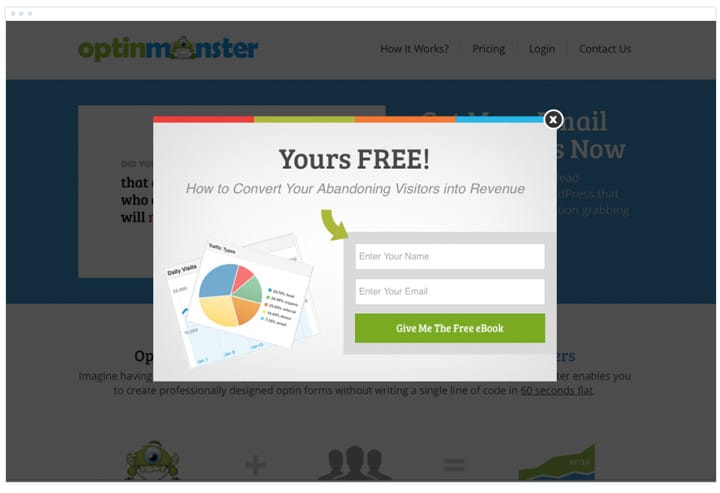
Best of all, Optin Monster integrates directly with Campaign Monitor, so you can automatically send any emails you capture through the tool straight to your chosen list.
AddThis
AddThis offers a suite of website tools that help drive traffic, increase conversions, and grow your email subscribers. With AddThis list building tools, you can encourage your visitors to sign up for your email list using mobile-friendly popups, sliders, and banners.
AddThis also provides the ability to target different audiences with your subscribe message based on factors such as whether or not they’re a new or returning visitor, social source, referring URL or campaign name, and more.
Best of all, AddThis list building tools integrate with Campaign Monitor, which means when visitors sign up for your email communications using AddThis, their information is automatically added to your Campaign Monitor subscriber list.
Integrations
If you’re looking to build your email list using email addresses you already have (I.e. From your existing customers), then integrating your existing CRM, accounting package or ecommerce platform with your Campaign Monitor account can be a great way to automatically add new customer information to your email lists.
Here are a few of the different tools you can integrate with your email marketing software to help build your email list:
- CRM tool – You can integrate your CRM system with your email marketing software to automatically pull new leads, prospects, and customers into your email lists.
- Ecommerce platform – You can integrate your ecommerce platform with your email marketing software to automatically pull all customers (along with granular customer data like purchase history) into your email lists.
- Accounting packages – If you keep a lot of your customer data in your accounting package, then you can integrate it with your email marketing software to automatically pulls your customers’ names and email addresses into your email lists.
If you’re a Campaign Monitor customer, you can benefit from deep integrations with CRM tools like Salesforce, as well as ecommerce platforms like Magento and Shopify, that will automatically add new customer information (including name, email address, last purchase date, amount spent, etc.) to your email lists (see more here).
Alternatively, third-party integration tools like Zapier allow you to automatically add new subscribers to your email list from over 500 other applications, including Google Sheets, Sugar CRM, Microsoft Dynamics, BigCommerce, WooCommerce, Quickbooks, Xero, Freshbooks, and more.
Chapter 6
Capture more than just the email address
By using the tools and following the two-step process outlined above, you should be able to grow the number of subscribers on your email list quite considerably.
However, the size of your list isn’t all that matters. In many ways, the quantity of subscribers you have is not as important as the quality of the subscribers you have. But what does subscriber quality actually mean?
A great email list has more data than just an email.
An email list with quality subscribers is one of the most important tools to have for your business. But why is it important, and why does quality beat out quantity in terms of value for your list?
This is admittedly a term that could be taken in multiple ways. On one hand, some would say a quality subscriber is one that benefits the company monetarily. They maintain a subscription on a paid tier, they make regular purchases, etc.
However, there is another way to look at the quality of a subscriber. Rather than gauging them solely by their financial impact on the company, consider ranking them by how much data you have on them.
The idea behind effective, targeted email marketing is to deliver the right content to the right recipient. The more insights a company has on a customer, the easier it is for them to deliver the relevant, helpful content that the subscriber is looking for.
The more information you have, the better your strategy will be. Even a polished, perfectly designed email can be boosted if it is optimized for a specific segment of your list.
In order to do this, you need to capture this information in your email subscribe forms at the same time you capture their name and email address. So, when creating your subscribe forms, consider adding some extra custom fields like:
- Gender
- Location
- Occupation
- Industry
- Role
- Number of employees
- Specialization (if you have a large number of subscribers in a specific industry segment)
- Opinion of brand
- Professional training level/education
- Profit (for B2B)
However, remember that making your subscribe forms longer can decrease the number of people who subscribe, so ensure to only include custom fields that you’ll actually use to segment and target your campaigns.
How do I set up an email list?
Subscribers may offer plenty of potential to your site and your brand, but the key is building a viable list to help you gain and retain those subscriptions. First, pick your preferred mailing platform and ensure they have all the features you need. Look for segmentation tools, testing options, and any integration options that your company requires.
Now that you have your software, the next step is to recall the two steps:
Step 1: Create simple subscribe opportunities.
Step 2: Offer a valuable incentive.
What are these incentives? They can include things like contest opportunities, custom discounts, long-term deals or price reductions, or anything similar. Think of what people love: to save money and to have a chance to win something great. These incentives are very valuable for growing your list.
You can also integrate your mail platform to use with any of the options mentioned above. If you have a platform that offers you a lot of tools for gathering insights, you can potentially find the best routes for growing your email list.
Do your customers seem to prefer one specific product or product line? Popular products could be the ones discounted. Have subscribers been keen to jump on limited-time sales in the past? Offer time-sensitive deals that help email readers truly benefit from reading on.
What is an email list?
If you’ve heard about email marketing, but you’re not sure how to get started, don’t worry. You’re not alone. But first, let’s define what a list is. A list is simply a group of email subscribers who have opted in to receive your emails. You can put a list together in a ton of different ways, like events, purchases, in-store visits, newsletters signups on your website, a piece of gated content. There are dozens of way to build an effective email list.
Have you ever seen a screen pop up on a website asking you to subscribe to their newsletter? Or have you read all the way to the bottom of a blog and seen an invitation to sign up for more related content?
These are prime examples of how organization’s have made effective lists. The good news is you can make one too!
Let’s talk about how you can make an email list in your email platform or ESP. Simply login to your ESP and choose the option to ‘Create New List’. Give this list a name and start adding subscribers. You can input your email list subscriber addresses if you know them. You can import them from a file. You can easily drag-and-drop a spreadsheet into your ESP.
Now that your list is created, you can set up signup forms to begin collecting email addresses on your website. You can also create forms to manually add subscribers to in-store events.
If you don’t know what your forms should look like, start with one or two must-have fields, like a first name and an email address. This is the quickest way to capture signups and typically the lowest barrier for entry. You can also include optional fields, like company type, gender, location, or interests.
These fields allow you to segment your list into different groups making personalization more intelligent. Just don’t go overboard with required fields since forms with too many fields can be overwhelming to your subscribers and be a bit of an eyesore. Once you’ve done that you can organize these fields in your ESP.
Do you want to keep growing your list? Consider hosting a giveaway on the most visited pages on your website.
To learn more, sign up for a free trial.
Chapter 7
Wrap up
With Facebook making it harder for your messages to be seen and Twitter’s click-through rates declining, knowing how to build an email list could be the best answer. This method is fast becoming a critical tool in every marketer’s arsenal.
Your email list is one of your most important marketing tools. Remember:
- Subscription opportunities should be simple and easy to follow
- When in doubt, use incentives
By following the two-step process presented in this guide and mixing easy-to-use subscribe options with a highly desirable incentive, you will be well on your way to building a massive email list that can help grow your business.
Use the methods and ideas you’ve learned in this guide to start building your email list today and help ensure that your subscribers stay loyal.

Press CMD+D to Bookmark this page

The #1 Salesforce Tool
Combine your account with Salesforce using the #1 integration, and experience better email.
Learn More
Case Study
Learn how Girls Who Code uses Campaign Monitor to change the tech world for the better.
Learn how
The email platform for agencies
We started out helping agencies with email, so let us help you.

